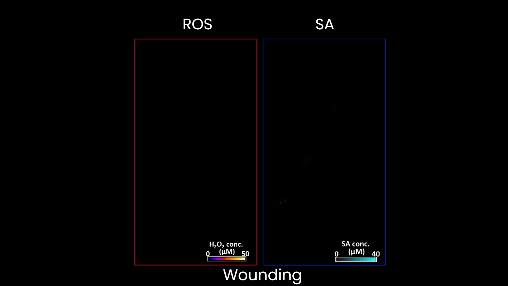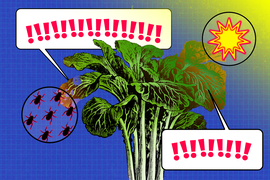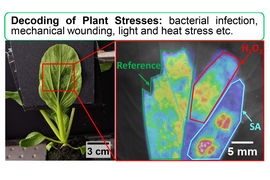Using a pair of sensors made from carbon nanotubes, researchers from MIT and the Singapore-MIT Alliance for Research and Technology (SMART) have discovered signals that reveal when plans are experiencing stresses such as heat, light, or attack from insects or bacteria.
The sensors detect two signaling molecules that plants use to coordinate their response to stress: hydrogen peroxide and salicylic acid (a molecule similar to aspirin). The researchers found that plants produce these molecules at different timepoints for each type of stress, creating distinctive patterns that could serve as an early warning system.
Farmers could use these sensors to monitor potential threats to their crops, allowing them to intervene before the crops are lost, the researchers say.
“What we found is that these two sensors together can tell the user exactly what kind of stress the plant is undergoing. Inside the plant, in real time, you get chemical changes that rise and fall, and each one serves as a fingerprint of a different stress,” says Michael Strano, the Carbon P. Dubbs Professor of Chemical Engineering at MIT and one of the senior authors of the study. Strano is also the co-lead principal investigator at the Disruptive and Sustainable Technologies for Agricultural Precision research group at SMART.
Sarojam Rajani, a senior principal investigator at the Temasek Life Sciences Laboratory in Singapore, is also a senior author of the paper, which appears in Nature Communications. The paper’s lead authors are Mervin Chun-Yi Ang, associate scientific director at SMART and Jolly Madathiparambil Saju, a research officer at Temasek Life Sciences Laboratory.
Sensing stress
Plants respond to different kinds of stress in different ways. In 2020, Strano’s lab developed a sensor that can detect hydrogen peroxide, which plant cells use as a distress signal when they are under attack from insects or encounter other stresses such as bacterial infection or too much light.
These sensors consist of tiny carbon nanotubes wrapped in polymers. By changing the three-dimensional structure of the polymers, the sensors can be tailored to detect different molecules, giving off a fluorescent signal when the target is present. For the new study, the researchers used this approach to develop a sensor that can detect salicylic acid, a molecule that is involved in regulating many aspects of plant growth, development, and response to stress.
To embed the nanosensors into plants, the researchers dissolve them in a solution, which is then applied to the underside of a plant leaf. The sensors can enter leaves through pores called stomata and take up residence in the mesophyll — the layer where most photosynthesis takes place. When a sensor is activated, the signal can be easily detecting using an infrared camera.

Image: Courtesy of the researchers
In this study, the researchers applied the sensors for hydrogen peroxide and salicylic acid to pak choi, a leafy green vegetable also known as bok choy or Chinese cabbage. Then, they exposed the plants to four different types of stress — heat, intense light, insect bites, and bacterial infection — and found that the plants generated distinctive responses to each type of stress.
Each type of stress led the plants to produce hydrogen peroxide within minutes, reaching maximum levels within an hour and then returning to normal. Heat, light, and bacterial infection all provoked salicylic acid production within two hours of the stimulus, but at distinct time points. Insect bites did not stimulate salicylic acid production at all.
The findings represent a “language” that plants use to coordinate their response to stress, Strano says. The hydrogen peroxide and salicylic acid waves trigger additional responses that help a plant survive whatever type of stress it’s facing.
For a stress such as an insect bite, this response includes the production of chemical compounds that insects don’t like, driving them away from the plant. Salicylic acid and hydrogen peroxide can also activate signaling pathways that turn on the production of proteins that help plants respond to heat and other stresses.
“Plants don't have a brain, they don't have a central nervous system, but they evolved to send different mixtures of chemicals, and that's how they communicate to the rest of the plant that it's getting too hot, or an insect predator is attacking,” Strano says.
Early warning
This technique is the first that can obtain real-time information from a plant, and the only one that can be applied to nearly any plant. Most existing sensors consist of fluorescent proteins that must be genetically engineered into a specific type of plant, such as tobacco or the common experimental plant Arabidopsis thaliana, and can’t be universally applied.
The researchers are now adapting these sensors to create sentinel plants that could be monitored to give farmers a much earlier warning when their crops are under stress. When plants don’t have enough water, for example, they eventually begin to turn brown, but by the time that happens, it’s usually too late to intervene.
“With climate change and the increasing population, there is a great need to understand better how plants respond and acclimate to stress, and also to engineer plants that are more tolerant to stress. The work reveals the interplay between H2O2, one of the most important reactive oxygen species in plants, and the hormone salicylic acid, which is widely involved in plants’ stress responses, therefore contributing to the mechanistic understanding of plants stress signaling,” says Eleni Stavrinidou, a senior associate professor of bioengineering at Linköping University in Sweden, who was not involved in the research.
This technology could also be used to develop systems that not only sense when plants are in distress but would also trigger a response such as altering the temperature or the amount of light in a greenhouse.
“We're incorporating this technology into diagnostics that can give farmers real-time information much faster than any other sensor can, and fast enough for them to intervene,” Strano says.
The researchers are also developing sensors that could be used to detect other plant signaling molecules, in hopes of learning more about their responses to stress and other stimuli.
The research was supported by the National Research Foundation of Singapore under its Campus for Research Excellence And Technological Enterprise (CREATE) program through SMART, and by the USDA National Institute of Food and Agriculture.













